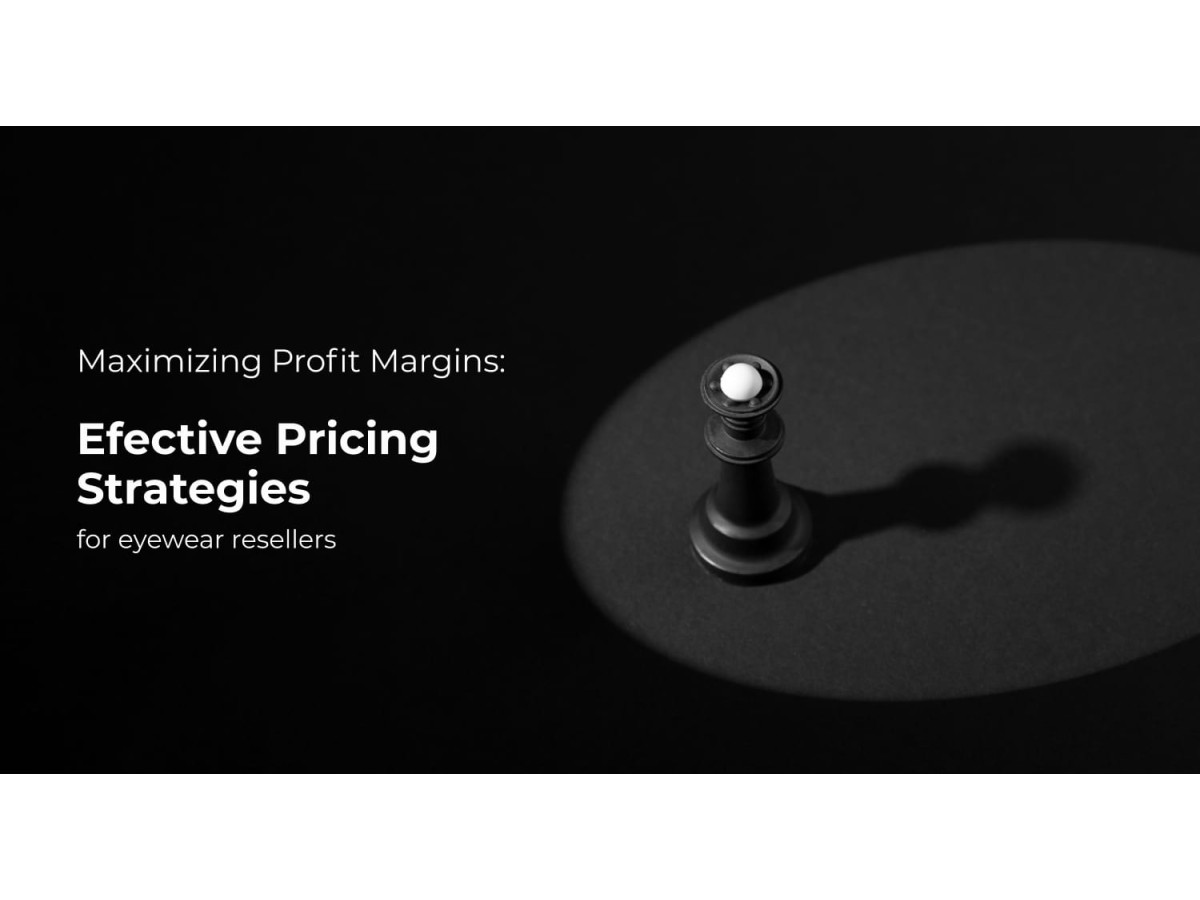In a competitive market like eyewear, pricing your products can be the difference between thriving or simply surviving. Setting the right price point not only ensures profitability but also positions your brand in the minds of consumers. For eyewear resellers, balancing profitability with competitive pricing can be tricky, especially when faced with fluctuating trends, overhead costs, and changing consumer demands. In this blog, we’ll explore actionable pricing strategies that can help eyewear resellers maximize profit margins while maintaining a competitive edge.
Understanding Cost Structures: Know Your Baseline
Before you can develop an effective pricing strategy, it’s critical to fully understand your cost structure. This involves calculating both direct costs (cost of goods sold, or COGS) and indirect costs (overheads like rent, utilities, marketing, and labor). By identifying all of your costs, you’ll be able to determine a pricing floor — the lowest possible price at which you can sell without incurring a loss.
Key Considerations:
• COGS: Include the cost of manufacturing or purchasing the frames, lenses, and any accessories. Don't forget shipping and handling.
• Overhead Costs: Think about your fixed costs (rent, insurance) and variable costs (staff salaries, marketing expenses) that influence your overall operating budget.
Once you have your total cost per product, you can begin developing pricing strategies that ensure profitability while accounting for market conditions.
Keystone Pricing: A Traditional Approach with Modern Adaptations
Keystone pricing is a commonly used strategy in retail, where the item is sold for double the wholesale price. This ensures that your business achieves a gross margin of 50%. For example, if you purchase a pair of frames for $100, you would sell them for $200.
Pros:
• Simplicity: Keystone pricing is easy to calculate and implement.
• Profit margin: It guarantees a healthy margin, which can sustain most eyewear businesses.
Cons:
• Not always competitive: While keystone pricing works for premium or exclusive products, it may not be the best approach for highly competitive or discount-driven markets.
Modern Adaptations: Eyewear resellers often tweak the keystone formula depending on the brand and market. For luxury frames, a higher markup (even 2.5x or 3x) might be applied, while budget eyewear lines may require a smaller markup to remain competitive. Consider adjusting the keystone method for high-end vs. low-end products to maintain a healthy profit margin across the board.

Value-Based Pricing: Let Perceived Value Drive Price
One of the most effective ways to maximize profits is to price based on the perceived value of your product rather than its intrinsic cost. Eyewear is not just about functionality but also about fashion, self-expression, and status. By highlighting these intangible benefits, you can often charge more for your products.
Steps to Implement Value-Based Pricing:
• Understand your target audience: What do your customers value most—brand recognition, style, sustainability, or luxury? Tailor your pricing accordingly.
• Communicate quality and exclusivity: High-quality materials (e.g., titanium or gold-plated frames) or collaboration with well-known designers can allow you to charge a premium.
• Provide a superior shopping experience: Offering customization options, in-store or online consultations, and excellent customer service can justify higher price points.
Example: If your frames are made from eco-friendly materials and are marketed as sustainable luxury, customers may perceive them as being worth more than a standard pair of plastic frames.
Tiered Pricing: Offering Variety to Boost Sales
Tiered pricing involves offering different levels of pricing for various product lines or service packages. This strategy can help you appeal to a wider audience while also encouraging upselling. By offering budget, mid-range, and premium frames, you can cater to different customer segments without compromising your margins.
How to Implement Tiered Pricing:
• Entry-level (Budget): Basic frames made from affordable materials like plastic or polycarbonate. Use these to attract price-sensitive customers.
• Mid-range: Slightly higher-quality frames with more stylish or unique designs. These could include stainless steel or acetate frames that offer durability.
• Premium: Luxury, designer, or custom-made frames that command a high price due to their brand or craftsmanship.
Why Tiered Pricing Works: It allows customers to trade up, giving them the choice to opt for higher-end products if they perceive added value. This can increase your average order value (AOV) and create a diversified revenue stream.

Psychological Pricing: The Power of Perception
Psychological pricing leverages human behavior and psychology to influence purchase decisions. There are several tactics eyewear resellers can use to boost sales without significantly lowering prices:
• Charm pricing: Pricing products just below a round number (e.g., $199 instead of $200) makes them appear more affordable, even if the difference is negligible.
• Price anchoring: Display a more expensive product next to your mid-range option to make the latter seem like a better deal.
• Bundle pricing: Offer package deals such as “Buy One, Get One 50% Off” or bundling frames with accessories like cleaning kits or protective cases to increase perceived value.
Why It Matters: Consumers are often swayed by how a price "feels" rather than its actual value. By implementing small tweaks to pricing presentation, you can enhance your customers’ perceived savings and encourage them to purchase higher-margin products.
Dynamic Pricing: Flexibility to Stay Competitive
Dynamic pricing allows you to adjust your prices based on real-time market demands, seasonality, or competitor pricing. This strategy works particularly well in the eyewear industry where trends, seasons, and customer demands fluctuate.
How to Apply Dynamic Pricing:
• Seasonal sales: Offer discounted prices during off-peak times or introduce surge pricing for popular holiday shopping periods, like Black Friday or back-to-school season.
• Monitor competitor pricing: Use tools to track competitors’ pricing in real-time and adjust your own prices accordingly to stay competitive without sacrificing margins.
• Customer segments: Offer exclusive discounts or pricing tiers for returning customers, loyalty program members, or email subscribers to encourage repeat business.
Why It Matters: Dynamic pricing keeps your store competitive, particularly in an online marketplace where consumers can easily compare prices. This strategy ensures you don’t leave money on the table during high-demand periods or price yourself out of the market.

Discounts and Promotions: Strategic, Not Routine
While it may seem counterintuitive to discuss discounts when focusing on profit margins, strategic discounting can actually help maximize profits by driving volume sales, clearing inventory, and attracting new customers. The key is to avoid offering discounts too frequently, as it can devalue your products in the long run.
Effective Discount Strategies:
• Seasonal promotions: Offer limited-time discounts during peak shopping periods (e.g., summer sales, end-of-year clearances).
• Volume discounts: Encourage bulk purchases by offering deals such as "Buy 2, Get 1 Free" or "20% off when you buy two pairs."
• Referral programs: Provide a discount for customers who refer friends or family to your store, expanding your customer base at minimal cost.
Why It Matters: By offering strategic discounts and promotions, you can boost short-term sales without damaging your brand’s perceived value or cutting into long-term profit margins.
Conclusion
Maximizing profit margins as an eyewear reseller requires more than just setting prices — it’s about understanding your market, identifying the value your products provide, and being flexible with your strategies. Whether you opt for keystone pricing, dynamic adjustments, or value-based pricing, staying adaptable and customer-focused will ensure that your business remains both competitive and profitable.
By incorporating these strategies into your pricing model, you’ll be well-equipped to balance profitability with customer satisfaction, setting the stage for long-term success in the ever-evolving eyewear market.



